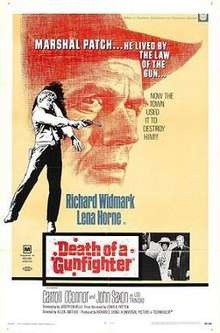Death of a Gunfighter
Death of a Gunfighter is a 1969 Western film. It stars Richard Widmark and Lena Horne, and features an original score by Oliver Nelson. The theme of the film is the "passing" of the West, the clash between a traditional character and the politics and demands of modern society.
| Death of a Gunfighter | |
|---|---|
 Theatrical release poster | |
| Directed by | Don Siegel Robert Totten both credited as: Allen Smithee |
| Produced by | Richard E. Lyons |
| Written by | Lewis B. Patten Joseph Calvelli |
| Starring | Richard Widmark Lena Horne Carroll O'Connor |
| Music by | Oliver Nelson |
| Cinematography | Andrew Jackson |
| Edited by | Robert F. Shugrue |
Production company | Universal Pictures |
| Distributed by | Universal Pictures |
Release date |
|
Running time | 94 minutes |
| Country | United States |
| Language | English |
Plot
In the town of Cottonwood Springs, Texas at the turn of the century, Marshal Frank Patch is an Old West style lawman in a community determined to be modern. When Patch kills drunken Luke Mills in self-defense, the town decides it is time for the marshal to resign. But Patch refuses, reminding the citizens that when he took the job, the agreement was he could have it as long as he wanted. Afraid of Patch because of his knowledge of their misdeeds in the town's wilder days, the city fathers then decide the only way to remove Patch from office is by violence.
Patch humiliates one of the town's councilmen, a cowardly shopkeeper, by slapping him. The man plans to kill Patch, but when Patch faces him down, he turns the gun on himself. The man's son swears revenge, supported by local leaders. They plot to ambush Patch. Aware that he will probably be killed, Patch marries his long-time girlfriend, the local brothel madame. The marriage is on the same day as the shopkeeper's funeral, after which Patch's death is planned. The dead man's son attempts to kill Patch on his own, but is shot by Patch. Patch explains to the dying youth that his father had murdered a man many years ago. Patch covered it up because he had agreed to raise the dead man's child. Patch pursues one of the instigators of the plot to kill him. He wounds and captures him, but then insists on going back out, knowing he will be gunned down. He is shot by hidden gunmen on the rooftops.
Alan Smithee credit
The film began under the direction of Robert Totten, an experienced television director (Gunsmoke, The Legend of Jesse James). After clashes with star Widmark, and almost a year of work, he was dropped and replaced by Don Siegel. When the film was finished Siegel did not want his name to replace Totten's. Widmark protested and an agreement was made with the Directors Guild of America for the pseudonym Alan Smithee to be used.
Despite the dispute, critics praised the film and its "new" director. The New York Times commented that the film was "sharply directed by Allen Smithee who has an adroit facility for scanning faces and extracting sharp background detail,"[1] Roger Ebert called the film "an extraordinary western ... director Allen Smithee, a name I'm not familiar with, allows his story to unfold naturally."[2]
Cast
- Richard Widmark as Frank Patch
- Lena Horne as Claire Quintana
- Carroll O'Connor as Lester Locke
- Jacqueline Scott as Laurie Mills
- John Saxon as Trinidad
- Dub Taylor as Doc Adams
- Darleen Carr as Hilda
- David Opatoshu as Edward Rosenbloom
- Kent Smith as Andrew Oxley
- Morgan Woodward as Ivan Stanek
- Royal Dano as Arch Brandt
- Jimmy Lydon as Luke Mills
- Victor French as Phil Miller
See also
References
- Thompson, Howard (May 10, 1969). "Screen: Tough Western: 'Death of a Gunfighter' Stars Widmark" New York Times Archived 2016-03-02 at the Wayback Machine
- Roger Ebert's review of Death of a Gunfighter